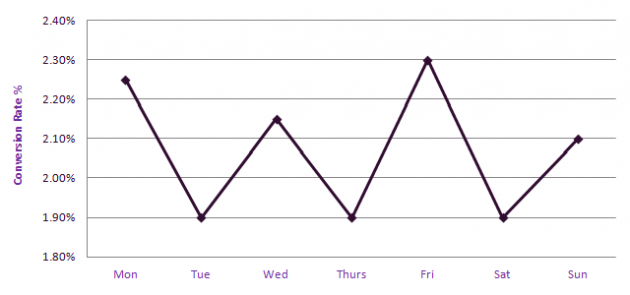As a PPC Analyst at Found, I have various strategies for setting keyword or ad group bids at the right level to maximise our clients’ revenue. One of the more advanced elements of this bid strategy is to adjust bids by day of the week with different weightings.
Why adjust PPC bids by day?
Well, time and time again we’ve found that conversion rates and EPCs (Earnings Per Click) change by day of the week. These trends are usually repeated week on week. Most the time it’s not a huge variation, only by 10%* or so, however on very high volume campaigns it will be worth investigating these trends, as even a small percentage gain can make a big difference to ROI. Google AdWords allows percentage changes of bids by day of the week at Campaign level via the ad scheduling function found under the settings tab.

It’s fairly simple within most paid search systems that extract data such as clicks, sales, revenue and EPC segmented by the day of the week. We suggest that you select a period without anomalies that might distort the conversion rate for any particular day of the week. For example, a last minute rush on the last day of a sale may result in a higher conversion rate for that day than usual. Below are two examples of conversion data segmented by day of the week, and a line graph which corresponds to the data gathered.
Example 1: Online Retailer


The above table and graph shows a clear drop in conversion on Saturday. I wouldn’t focus on the dip on Tuesday. The interesting trend found in this data set is the peak on Friday, followed by a large decline on the Saturday. This would seem a realistic trend, with a last minute rush occurring on Friday for various events on the weekend. The lack of delivery on Sunday probably results in a drop conversion rate on Saturday as people are much more likely to opt to use high street shops.
Example 2: Travel Sector


This example shows a substantial difference in conversion rate from the peak to the trough. If coupled with high traffic, this is likely affect the ROI of an account, with a downward trend throughout the week.
How do you take advantage of these swings in conversion rate? Well, first of all you calculate the overall conversion rate. .
For the above data this is 2.05%. Once you have this figure, you calculate the percentage difference each day from this mean conversion rate.

Again, once you have worked out the recommended percentage multiplier you can interpret it, and perhaps action campaign changes by optimising budgets or bids for the most important days. There are other factors to consider though, one of these being where your clicks interact on the conversion funnel.
Now a word of warning; although trends may be apparent, it can be random noise. If you are assigning conversions by the last click, you may under estimate the value of first and middle clicks, which can be an essential route to the final conversion. Click-path analysis is a whole topic of its own, and for now I’ll assume it has no effect.
How do you draw out a real trend from statistical noise? There are of course various statistical tests, for example a basic chi squared test.
If you want a more human touch, the following advice may help. I suggest that you need a conversion rate or EPC change of above +/- 10% with over 400 sales required for each day. By rule of thumb, if the trends seems unlikely, it can be ruled out. For example if the conversion rate oscillates up and down with peaks throughout the week, then this may seem to be noise. Meanwhile, a clear build up to a peak, perhaps on a Friday or Saturday might be more likely.

If there are logical reasons for the trend and it is repeated across the sector, then this would give you a reason to have confidence in your data.
In summary, dayparting isn’t the silver bullet that is going to transform your campaigns, but it can act as an important addition where more obvious strategies have been carried out. I’d be interested in hearing more about your experiences and use of dayparting.
*10% up and down on the average, i.e. A conversion rate of 18% would represent a 10% negative change on an average conversion rate of 20%.

